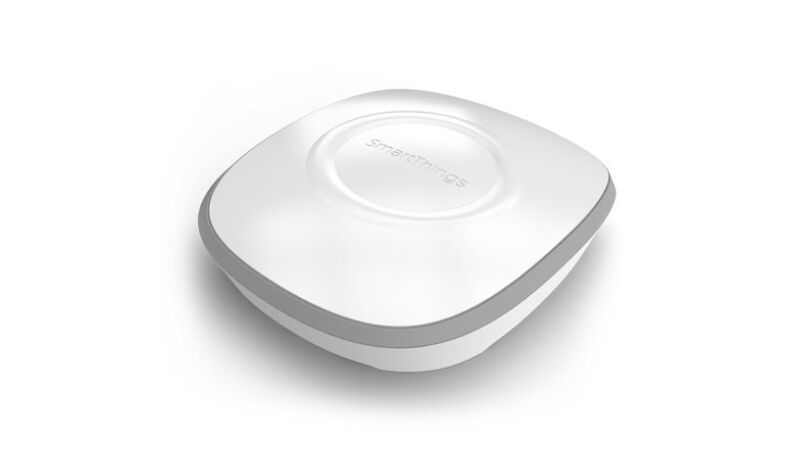
Samsung has spent the last year or so upending its SmartThings ecosystem. SmartThings was born as an independent company in 2012 when it launched one of the largest Kickstarter campaigns ever: a $1.2 million funding program for the company's first smart home hub. Samsung bought SmartThings in 2014, and in June 2020, the Korean giant announced a plan that would basically shut down all of the stuff it acquired, forcing everyone over to in-house Samsung infrastructure. A big part of that plan is happening at the end of the month, when Samsung will kill the first-generation SmartThings Hub.
The SmartThings Hub is basically a Wi-Fi access point—but for your smart home stuff instead of your phones and laptops. Instead of Wi-Fi, SmartThings is the access point for a Zigbee and Z-Wave network, two ultra low-power mesh networks used by smart home devices. Wi-Fi is great for loading webpages and videos, but it's extreme overkill for something like turning on a light switch or working a door sensor; these things need to just send a few bits for "on or off" or "open or closed." Zigbee and Z-Wave are so low-power that you can run the devices on AA or coin cell batteries for months. The Hub connects your smart home network to the Internet, giving you access to a control app and connecting to other services like your favorite voice assistant.
You might think that killing the old Hub could be a ploy to sell more hardware, but Samsung—a hardware company—is actually no longer interested in making SmartThings hardware. The company passed manufacturing for the latest "SmartThings Hub (v3)" to German Internet-of-things company Aeotec. The new Hub is normally $125, but Samsung is offering existing users a dirt-cheat $35 upgrade price.
For users who have to buy a new hub, migrating between hubs in the SmartThings ecosystem is a nightmare. Samsung doesn't provide any kind of migration program, so you have to unpair every single individual smart device from your old hub to pair it to the new one. This means you'll need to perform some kind of task on every light switch, bulb, outlet, and sensor, and you'll have to do the same for any other smart thing you've bought over the years. Doing this on each device is a hassle that usually involves finding the manual to look up the secret "exclusion" input, which is often some arcane Konami code. Picture holding the top button on a paddle light for seven seconds until a status light starts blinking and then opening up the SmartThings app to unpair it.Samsung is also killing the "SmartThings Link for Nvidia Shield" dongle, which let users turn Android TV devices into SmartThings Hubs. We're in phase two of Samsung's SmartThings armageddon now. Phase one was in October, when Samsung killed the Classic SmartThings app and replaced it with a byzantine disaster of an app that it developed in house. Phase three will see the shutdown of the SmartThings Groovy IDE, an excellent feature that lets members of the community develop SmartThings device handlers and complicated automation apps. Even if a piece of hardware didn't officially support SmartThings, the IDE let the community develop its own support for the device. There's no detailed timeline for phase three, but shutting down community device handlers will definitely break things.
Samsung's goals with all this upheaval are unclear. The company isn't just killing the OG SmartThings Hub; it's taking away much of the appeal of the SmartThings ecosystem. Before Samsung started smashing up the place, SmartThings represented the biggest smart home community out there, and complicated but powerful tools like the Groovy IDE let the community fill in software blanks. With Samsung proving to be an unstable steward of the platform, many users are moving over to the self-hosted Home Assistant.
June 04, 2021 at 01:29AM
https://ift.tt/2SVVQOZ
Samsung will shut down the v1 SmartThings hub this month - Ars Technica
https://ift.tt/2O3clnm
/article-new/2021/06/iphone-13-duan-rui2.jpeg?lossy)
No comments:
Post a Comment